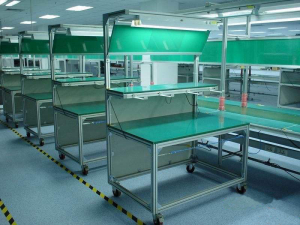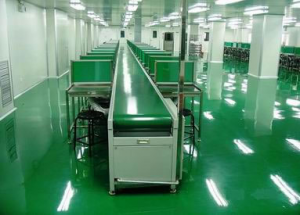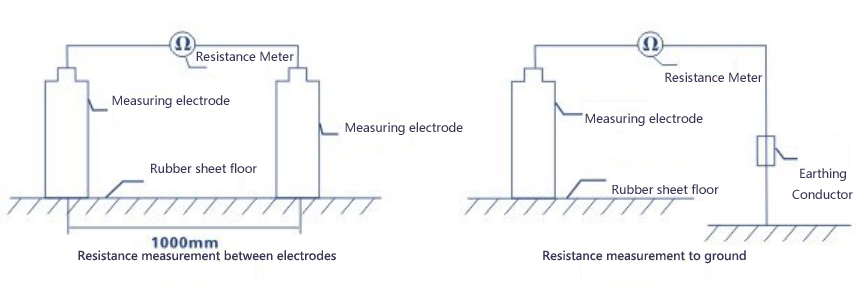Product
Anti-static mat (Smooth/Glossy surface)
Anti-static rubber mat / ESD table sheet / ESD floor mat (Smooth/Glossy surface)
The anti-static mat (ESD sheet) is mainly made of anti-static material and static dissipate synthetic rubber material. It is usually a two-layer composite structure with a thickness of 2mm, the surface layer is a static dissipation layer about 0.5mm thick, and the bottom layer is a conductive layer about 1.5mm thick.
The company’s anti-static rubber sheets (table mats, floor mats) are made of 100% high-quality rubber, and we promise to never contain any inferior rubber, waste rubber, reclaimed rubber, and plastic components. Non-slip table mats and floor mats can be customized according to customer requirements (length, width, thickness, color, etc. can be selected).
The products have passed SGS testing and comply with RoHS standards.
Specification available to supply
Product Name Anti-static mat/sheet/pad/cushion
Part # ESD-1002
Material Anti-static material and static dissipate synthetic rubber
Size 10mx1.2m,10mx1.0m,10mx0.9m,10mx0.8m,10mx0.7m,10mx0.6m
Color Green/Black,Blue/Black,Gray/Black,Yellow/Black,Black/Black,
Thickness 1.0mm,2.0mm,3.0mm,4.0mm,5.0mm
Conductivity 106-109Ω
Style Smooth/Glossy surface
Description of goods
| Surface treatment | Pattern/Smooth/Glossy/Dull/Antislip |
| Size(LXW) | 10mx1.2m,10mx1.0m,10mx0.9m,10mx0.8m,10mx0.7m,10mx0.6m |
| Color | Green/Black,Blue/Black,Gray/Black,Yellow/Black,Black/Black, White/Black |
| Thickness | 1.0mm,2.0mm,3.0mm,4.0mm,5.0mm |
Technical Specifications:
| Item | Data |
| Resistivity of surface layer | 106-109Ω |
| Resistivity of bottom layer | 103-105Ω |
| Bulk Resistvity | 105-108Ω |
| Abrasistivity loss | <0.02g/cm2 |
| Hardness | 70-75 |
| Time for static dissipation | <0.1s |
| Temperature resistance | -70℃~ 300℃ |
Customized: Can be customized according to customer requirements (length, width, thickness, color, style etc. can be selected).
Features: Green and environmental protection, anti-static rubber sheet resistance is stable, eliminates the accumulation of static electricity on the human body and the environment, prevents static electricity hazards and accidents, effectively leaks the static electricity on the human body, tooling, equipment, and materials into the earth, and eliminates the harm of human body and environment static electricity. Prevent fire and explosion accidents caused by electrostatic discharge in the production site of flammable and explosive products; prevent the breakdown of components and components caused by electrostatic discharge in the production site of electronic products; relieve the electrostatic shock and mental burden caused by electrostatic discharge of operators .
Physical properties: acid resistance, alkali resistance, oil resistance,high temperature resistant to 300℃ without discoloration, 400℃ non-burning, low temperature resistance -30℃~-70℃ without decomposition; the color is generous, extremely lining the workbench, and the production environment. In addition to all the functions and properties of anti-static anti-slip table mats and floor mats, anti-static anti-slip table mats and floor mats also have a good anti-slip effect.
Applications:
Electrostatic and anti-static rubber sheets (table mats, floor mats) are suitable for aerospace, national defense, coal mines, black powder, pyrotechnics, electric explosives, ammunition charge assembly, civilian blasting equipment, fireworks, electronic components, electronics, instruments and meters, liquefied petroleum gas tank stations, electronic semiconductor devices, electronic computers, electronic communication equipment, and integrated circuit microelectronics industries production workshops and warehouses paving static conductive rubber sheets, anti-static rubber sheets on the ground and work surfaces in order to eliminate The human body and the environment accumulate static electricity to prevent static electricity hazards and accidents and take necessary electrostatic safety protection measures.
The function of paving static conductive and anti-static rubber sheet (table mat, floor mat) ground and work surface is to effectively leak the static electricity on the human body, tooling, equipment, and materials into the earth, eliminating the harm of static electricity on the human body and the environment. Prevent fire and explosion accidents caused by electrostatic discharge in the production site of flammable and explosive products; prevent the breakdown of components and components caused by electrostatic discharge in the production site of electronic products; relieve the electrostatic shock and mental burden caused by electrostatic discharge of operators.
Laying of anti-static rubber sheet:
There are two laying methods for conducting static electricity and antistatic rubber sheets (table mats, floor mats): floating and pasting.
Floating paving is to lay 2-5mm thick rubber sheets directly on the ground, which is flexible and easy to lay, but the gaps between the rubber sheets are easy to accumulate dust.
Pasting is to paste the 2-5mm thick rubber sheet with electrostatic conductive rubber stick on the ground. The gap between the rubber sheets can be 1.2X1000X10000mm thin rubber sheet and cut into a 30-50mm wide rubber strip with a paper knife, and then apply the electrostatic conductive rubber liquid Paste on the gap surface at the joint of the rubber sheet. You can also use a paper cutter (or a special knife) to cut the straight edge of the 5mm thick rubber sheet into positive and negative slopes and slightly roughen it, and then apply the electrostatic conductive rubber liquid for lap bonding.
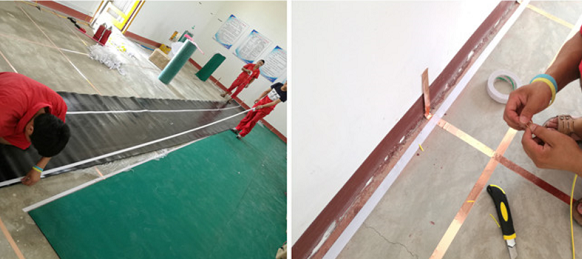
Basic ground requirements:
Wooden floors, asphalt floors, floors of two-story buildings and above are insulated floors. Copper sheets must be attached to the ground before rubber sheets are laid. Copper sheets are generally made of thin copper strips, and the copper sheets are pasted on the ground. Installed in a rectangular grid that intersects horizontally and vertically. The size and quantity of copper patch placement can be determined according to the needs of their respective production workshops and warehouses. The patched copper plates are fixed and reliably connected to the static grounding branch (or trunk) to provide static electricity leakage channel. For non-insulated ground such as cement ground and terrazzo ground on the first floor, copper sheets may not be attached, and rubber sheets can be directly laid on the ground.
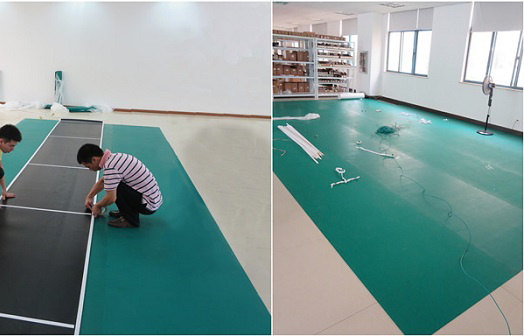
Notifications for rubber sheet and ground sticking:
1. The ground and rubber sheets should be free of dust, oil, and moisture, and must be clean and dry;
2. Clean the surface to be pasted with 120°gasoline before pasting, and then apply rubber liquid after drying;
3. The ambient temperature requires 25℃-42℃, the relative humidity is not higher than 60%, with good ventilation;
4. It is best to use coarse grinding wheel, coarse sandpaper, wooden file, etc. to lightly roughen the adhesive surface of the rubber plate (the edge of the adhesive surface must be roughened for 30-50mm);
5. The rubber liquid must be brushed twice with a brush on the ground and rubber plate surface to be pasted. The first time is to dry for 20-30 minutes, and the second time to dry to slightly sticky hands can be pasted;
6. If the rubber liquid is too thick and inconvenient for construction, it can be diluted by adding toluene according to the ratio of 10-20% of the rubber liquid, and then mixed evenly.
7. After the rubber sheet is pasted on the ground, roll it for more than 5 times with a round roller weighted more than 5 kg;
8. Pay attention to ventilation and fire prevention during construction;
9. During the use of the rubber sheet floor, if it is found to be dry and curled due to mechanical operation, etc., the above-mentioned pasting method can be used to repair.
Resistance measurement of anti-static rubber sheet flooring
The measuring instrument is an insulation resistance tester, with a DC open circuit voltage of 500V and a short circuit current of 5mA. The measuring electrode is made of copper or stainless steel into a cylindrical standard electrode with a diameter of 60±2mm and a weight of 2±0.2 kg. The measuring electrode must be treated with anti-oxidation.
1. Place two measuring electrodes 1m apart on the ground, connect the two terminals of the meter to the electrodes, and measure the resistance between the electrodes;
2. Place a measuring electrode on the ground, connect one terminal of the meter to the electrode, and connect the other terminal to the grounding grid of the workshop and warehouse (if there is no grounding grid, it can be connected to the water-filled water pipe), and measure the point ground resistance value;
3. At least 5 measuring points should be selected for each workshop and warehouse. The measuring points should be selected in the place where the production workers operate and move frequently, and the distance from the grounding body should be 1m;
4. Regardless of the resistance value between the poles or the polar resistance value, should taken the arithmetic mean value;
5. The ground resistance value of the static conductive rubber sheet is ≤5X104Ω or 5X104-106Ω; the ground resistance value of the antistatic rubber sheet should be in the range of 106Ω-109Ω.



